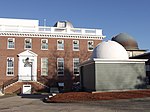William Dean Howells House (Cambridge, Massachusetts)
Houses completed in 1873Houses on the National Register of Historic Places in Cambridge, Massachusetts

The William Dean Howells House is a house built and occupied by American author William Dean Howells and family. It is located at 37 Concord Avenue, Cambridge, Massachusetts. The house was designed by Howell's wife, Elinor Mead, and occupied by the family from 1873 to 1878. Authors including Mark Twain, Henry James, Henry Wadsworth Longfellow, and Thomas Bailey Aldrich visited the Howells in this house, as did President James Garfield, and Helen Keller lived there afterwards while attending school.
Excerpt from the Wikipedia article William Dean Howells House (Cambridge, Massachusetts) (License: CC BY-SA 3.0, Authors, Images).William Dean Howells House (Cambridge, Massachusetts)
Concord Avenue, Cambridge
Geographical coordinates (GPS) Address External links Nearby Places Show on map
Geographical coordinates (GPS)
| Latitude | Longitude |
|---|---|
| N 42.38025 ° | E -71.126666666667 ° |
Address
William Dean Howells House
Concord Avenue 37
02138 Cambridge
Massachusetts, United States
Open on Google Maps









